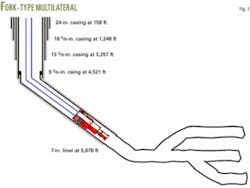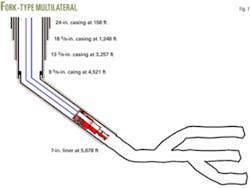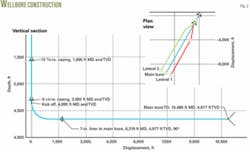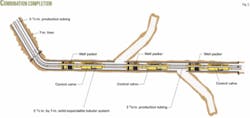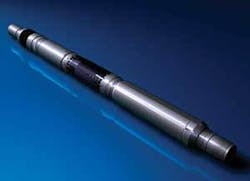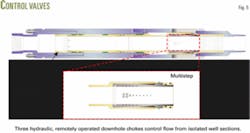Expandable tubulars facilitate intelligent technology placement
Installation of solid expandable tubulars in combination with intelligent-well technology facilitates remedial operations in multilateral wells in a Saudi Arabia oil field producing from a limestone reservoir.
The field’s development included long reach, openhole multilateral wells that produce at high rates. The inability to reenter the openhole sidetracks for remedial work, however, hampered recovery. In wells producing water, the operator either could not identify the source of the water or if found, could not remediate the problem.
The introduction of solid expandable tubulars in combination with intelligent-well technology overcame this problem. Wells with this technology generally have higher production rates and greater recoveries. Lower unit development and operating costs also are key drivers for installing this technology.
Solid expandable tubulars combined with intelligent-well technology allows for reentry into laterals for remedial work and to obtain real-time pressures, temperatures, and flows without the need for well intervention. Intelligent-well components allow for quick identification of water-producing zones and provide a means for shutting off water production without the need for well intervention.
Integrating technology
Completion reliability and the potential for higher sustainable production rates are two major drivers that have led to the acceptance of intelligent-well technology. Combined with solid expandable tubulars, operators can install the technology during workovers in wells previously unable to benefit from intelligent completions.
During the early to mid-1990s, development of intelligent-well technology was in its infancy. Conventional completion methods requiring intervention were the primary means for completing oil and gas wells.
The move to deepwater and extended-reach drilling (ERD) motivated increasing the reliability of this technology because these environments require high flow rates for economical production. With respect to wells drilled with solid expandable tubulars, operators are able to expose more reservoir rock while maintaining optimum control of the production profile.
The ongoing improvements in drilling equipment, drilling fluids, downhole tools, and ancillary items continue to expand the envelope for intelligent wells in combination with solid expandable tubulars. As with any other evolving technology, however, limitations exist that must be addressed. Wellbore preparation and well-path architecture must meet certain minimum requirements to facilitate successful placement of a solid expandable liner.
The industry now has bits and underreaming devices that enable isolating longer intervals while maintaining the required casing geometry to accommodate the intelligent-well equipment. Wellbore cleanup tools help in placing solid expandable tubulars. Other improvements in the hardware associated with the intelligent completion systems ensure that the completion will be fit-for-purpose.
Drilling equipment also has advanced. The industry now has available bottomhole assemblies that drill straighter holes and eliminate the spiraled tortuosity normally associated with conventional drilling assemblies. These advancements enhance hole cleaning and reduce torque and drag to allow placement of solid expandable liners on depth.
An obvious advantage of combining intelligent-well technology with solid expandable tubulars is that it can control the flow from the added reservoir rock exposed in multilateral wellbores as if the flow was in a single wellbore.
This type of completion also facilitates remedial drilling operations should they become necessary. In a multiple-well development project, this technology potentially can reduce overall well count and thereby reduce overall project capital expenditures.
These factors are critical in deepwater and ERD-type wells where development requires greater capital than in conventional locations.
Larger reservoirs that can produce at high rates and have higher recoverable volumes are targets for this combined technology. Also, for the costly environments of deepwater and ERD drilling, another key issue in well design is completion reliability.
Integrating drilling and completions is critical in developing openhole, horizontal wells because the drilling process can influence the productivity and cycle time for the completions. The industry has a growing recognition that hole quality directly affects successful deployment of expandable casing and thus completion reliability.
Previous wells show that poor hole quality was a major factor for failure of expandable casing liners to reach the planned setting depth. Irregular hole geometry can lead to problems with hole cleaning and with increased torque and drag.
Debris in the hole can induce stress risers on the expandable liner OD and lead to failure during the expansion process. These failures might be due to the expandable casing rubbing against debris when going through tight spots in the wellbore.
Conventional downhole-steerable motors require periods of oriented drilling, during which the drillstring is not rotating. This lack of rotation can lead to washouts and increased wellbore tortuosity. Furthermore, drilling with conventional steerable assemblies may result in an irregular hole geometry such as a corkscrewed wellbore.
Rotary-steerable tools can have a positive effect on drilling costs as well as the ability to deploy effectively the solid expandable casing. Rotary-steerable assemblies guide the system in the wellbore in any given direction while rotating the drillstring. This feature results in a straighter hole with less variance in gauge drift. Some advantages of rotary-steerable systems include:
- Lower wellbore friction, which aids in running the casing to depth.
- Improved hole cleaning and minimized drill pipe trips, which result in less time required for circulating and tripping.
- Minimized time that the open hole is exposed, which reduces the risk of hole collapse and washouts.
- Reduced spiraling, which provides better logs.
These advantages enhance the odds of successfully deploying the expandable liner to bottom. Reducing washouts minimizes chances of low spots where debris could accumulate and damage the expandable liner during deployment.
An added benefit in ERD wells is the ability to drill longer hole sections.1 The combination of rotary-steerable tools and near-bit reaming devices to open the wellbore is another positive factor in helping ensure that the expandable liner reaches the planned depth.
Field development
Installation of the solid expandable tubulars combined with intelligent-well technology occurred in a field located in a desert terrain consisting of salt flat areas and mountainous sand dunes up to 600 ft high. Because of rugged terrain, initial field development was from a limited number of flat areas so that the wells required highly accurate directional drilling to reach their targets.
The field, developed in the mid-1990s, produces 42° gravity oil and includes 1-km long, single-lateral horizontal wellbores. The field went on production in 1998.
Because of a large gas cap and a relatively weak aquifer, the horizontal completions minimized the chances of early water breakthrough and provided the desired economic production rates. The operator recognized that additional laterals in the same zone could yield substantially improved production results, thereby increasing reservoir contact. Subsequently, it drilled two laterals off the main bore in an angle that resembles a fork (Figs. 1 and 2).
Historic field data have shown that a fork-type multilateral to be the best fit for this field application compared to fishbone or some other type.
A workover converted the existing 1-km horizontal well into a trilateral fork-type multilateral. Total reservoir exposure from the three legs was more than 18,000 ft.
Workover
The workover included underreaming the original main bore to 7½-in. from 6 1/8 in. in a 1,209-ft interval measured from the 7 in. shoe. Then a 2 7/8 in., PH-6 inner-string ran the 5½× 7-in. expandable liner in the hole. Once on depth, circulation of water ensured adequate hole cleaning while batch mixing spacer and slurry.
The next step pumped 10 bbl of spacer and 28 bbl of cement, displaced with 55 bbl of water, as the well program called for. After landing of a dart, the program included pressure testing the liner before its hydraulic expansion. Expansion initiation pressure was 5,100 psi and subsequent expansion of the 1,010-ft liner required pressures between 4,500 and 4,800 psi. A pressure to 1,500 psi for 30 min tested the liner.
The next step involved running a cement retainer and setting it at 6,697 ft, followed by the running of a 5¼-in. OD whipstock inside the expandable liner and setting it on top of the cement retainer after it was oriented 54° left. The drilling of the lateral was through a window milled in the casing from 6,678 to 6,690 ft with a 5½-in. directional drilling assembly. The lateral achieved a 4,625-ft length before retrieval of the whipstock in preparation for drilling of the second lateral.
Drilling the second lateral involved running a retrievable plug and setting it at 6,430 ft. A whipstock run on top of the plug had a 55° right orientation.
A 5½-in. assembly also drilled the second lateral. This lateral achieved a 7,340-ft length, better than expected. A concave mill drilled out the float shoe in the expandable liner after retrieval of whipstock and plug.
The final step in the workover operation involved installing the intelligent completion system, which included:
- Three fit-for-purpose retrievable, hydraulic-set packers (Figs. 3 and 4).
- Three control valves (Fig. 5).
- Required encapsulated hydraulic control lines.
The procedure called for function testing of all critical components before their arrival at the well site. The workover operation paid particular care to ensure the hydraulic lines were undamaged while running the completion system in the hole. After the completion system was on depth, the next step closed control valves and tested tubing to 3,000 psi to set the packers.
Because these packers have no mandrel movement, they set simultaneously. The next steps tested the packers to 1,500 psi for 30 min and each control valve through 10 choke settings to ensure functionality.
After completion of workover operations, the well had more than 18,000 ft drilled in the reservoir; more than 11,000 ft from the two laterals drilled through the window exits in the expandable liner.
The well subsequently produced 6,000 bo/d with 6% water cut compared with 1,500 bo/d at 15% water cut before the workover.
Based on the increased production, the operator recovered all workover costs in about 10 days.
Observations
This application in a limestone reservoir describes one of the first successful installations of intelligent-completion equipment inside an expandable liner. The work encountered no serious difficulties because of lessons learned on other projects. The combination of these technologies provides several benefits:
- Ability to drill long lateral lengths after exiting the window cut in the expandable liner.
- Controlled liner ID, which aids in friction reduction and minimizes helical buckling.
- A large 5.570-in. ID through the liner, which allowed the use of 4-in. drill pipe with high torque connections, thereby enhancing drilling operations.
- Improved cement bond due to the expansion process squeezing out unwanted stringers.
- Ability to monitor and manage the flow from each lateral in real time with no wellbore intervention required.
Reference
- Filippov, A., Akhideno, M., Zijsling, D., Waddell, K., Costa, S., Watson, B., and Bell, B., “Continued Evolution of the One-trip Expansion, Single-diameter Wellbore,” Paper No. OTC 17437-PP, Offshore Technology Conference, Houston, May 2-5, 2005.
Based on a presentation to the SPE Annual Technical Conference and Exhibition, San Antonio, Sept. 24-27, 2006.
The authors
Mark Rivenbark is area general manager for Enventure’s Middle East offices. He previously was sales manager in Saudi Arabia for Halliburton Energy Services and has held various field level and management positions with Dresser Industries. Rivenbark has a degree in applied science from the University of Alaska-Anchorage and is a member of the SPE and AADE.
Khaled Abouelnaaj’s biography and photo were unavailable at press time.
